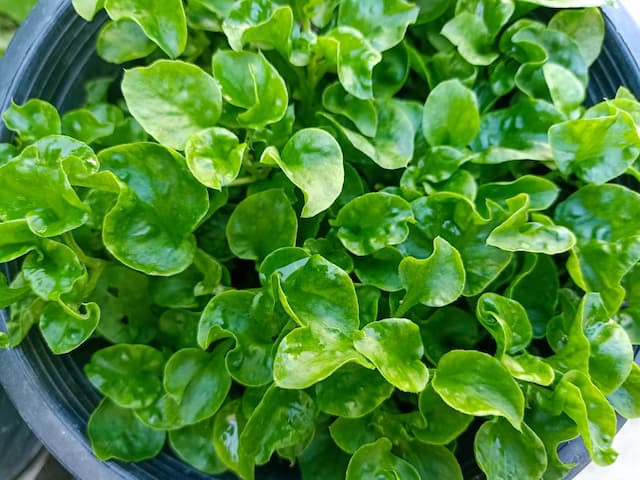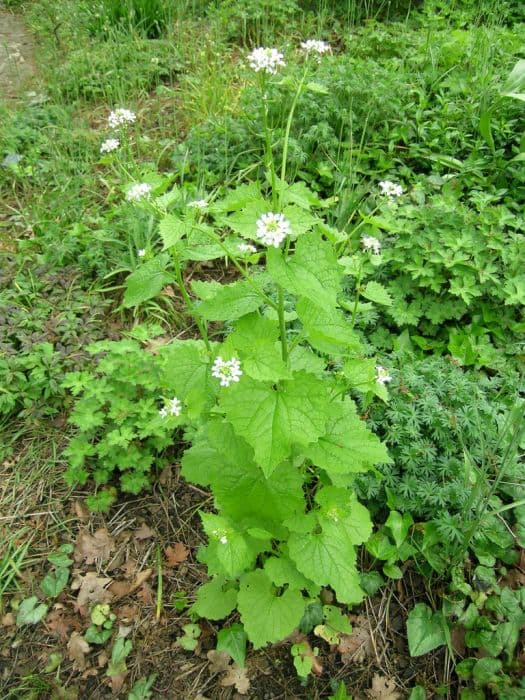Crinkleroot Cardamine quinquefolia

ABOUT
Cardamine quinquefolia, commonly known as the narrowleaf bittercress, features delicate, small white flowers that have four petals forming a cross shape typical of its family. The flowers grow clustered atop slender stems that appear to be frail but are actually quite resilient. The foliage of this plant stands out with bright green leaves, divided into five distinct leaflets that are oblong with smooth edges, giving the plant an airy, feathery texture. These leaves can take on a slightly yellowish or bluish-green tint depending on the light and environment. The narrowleaf bittercress is a woodland plant, often found carpeting the ground in a lush green with its delicate blossoms rising above the foliage in a subtle, decorative manner. This growth habit creates an enchanting, fairy-like atmosphere in the habitats it graces.
About this plant
 Names
NamesFamily
Brassicaceae
Synonyms
Slender Toothwort, Narrowleaf Bittercress, Light Yellow Bittercress, Quinquefolia Bittercress
Common names
Cardamine pentaphyllos, Dentaria quinquefolia, Dentaria pentaphyllos.
 Toxicity
ToxicityTo humans
Cardamine quinquefolia, commonly known as slender toothwort, is not widely recognized as a toxic plant to humans. However, like with any plant, individual allergies or sensitivities could occur. It is always advisable to be cautious when handling or ingesting unknown plants. If you believe you've ingested any part of this plant and are experiencing adverse effects, seek medical attention.
To pets
Slender toothwort is not commonly listed as a toxic plant to pets. Nevertheless, pet owners should be cautious and prevent pets from consuming plants that are not part of their regular diet. If a pet ingests slender toothwort and shows signs of distress such as vomiting or diarrhea, contact a veterinarian.
 Characteristics
CharacteristicsLife cycle
Perennials
Foliage type
Deciduous
Color of leaves
Green
Flower color
White
Height
1 feet 8 inches (50 cm)
Spread
1 feet (30 cm)
Plant type
Herb
Hardiness zones
4
Native area
Europe
Benefits
 General Benefits
General Benefits- Ecosystem Support: Cardamine quinquefolia, commonly known as crinkleroot or fiveleaf bittercress, serves as a food resource for a variety of pollinators, such as bees and butterflies.
- Soil Stabilization: The root system of crinkleroot helps stabilize soil and prevent erosion in the forested areas where it commonly grows.
- Aesthetic Appeal: With its delicate white flowers, crinkleroot adds natural beauty to woodland gardens and shaded areas.
- Habitat Creation: As part of the undergrowth in forests, crinkleroot provides habitat and shelter for numerous small animals and insects.
- Seasonal Interest: The plant offers a seasonal display of foliage and flowers in the springtime, marking the change of seasons in its natural environment.
- Cultural Significance: In some cultures, crinkleroot is appreciated for its unique appearance and is sometimes used in traditional landscaping practices.
- Low Maintenance: Crinkleroot typically requires minimal care in its native habitat, making it a low-maintenance addition to compatible landscapes.
- Edible Uses: The leaves and roots of crinkleroot are edible and are sometimes foraged for culinary uses in wild salads and dishes (Note: only those who are expertly knowledgeable in wild plant foraging should consume wild plants).
 Medical Properties
Medical PropertiesThis plant is not used for medical purposes.
 Air-purifying Qualities
Air-purifying QualitiesThis plant is not specifically known for air purifying qualities.
 Other Uses
Other Uses- Cardamine quinquefolia, commonly known as the Slender Toothwort, can be used in butterfly gardens as it attracts certain species of butterflies and moths which prefer its nectar or use it as a larval host.
- In small-scale landscaping, Slender Toothwort is appreciated for its delicate appearance and can be used to create a woodland garden aesthetic, particularly under deciduous trees.
- Some enthusiasts of miniature and fairy gardens plant Slender Toothwort as it lends a 'wild' look and provides beautiful white to pink spring blooms.
- The plant has potential as a natural ground cover in shaded areas, thanks to its carpeting nature that can help prevent soil erosion.
- Slender Toothwort is sometimes used in educational settings, like school gardens, to teach about native plant species and their role in local ecosystems.
- The species is of interest to ecologists and botanists for research into plant adaptation and competition in woodland environments.
- In colder climates, Cardamine quinquefolia is used as an early bloomer to indicate the coming of spring and to provide early season greenery.
- Photographers and artists may utilize the aesthetic of Slender Toothwort's blooms for their work, capturing the essence of spring woodlands.
- Slender Toothwort can be used in culinary presentations, as its delicate flowers may serve as edible garnishing for salads and cold dishes, though it's not commonly consumed.
- Enthusiasts of historical gardening sometimes include Slender Toothwort in gardens designed to mimic those of the past, as this plant is native to North America and has been present for centuries.
Interesting Facts
 Feng Shui
Feng ShuiThe Cardamine is not used in Feng Shui practice.
 Zodiac Sign Compitability
Zodiac Sign CompitabilityThe Cardamine is not used in astrology practice.
 Plant Symbolism
Plant Symbolism- Adaptation: Cardamine quinquefolia, more commonly known as the Slender Toothwort, often grows in woodland settings, showcasing its ability to thrive in shaded and specific soil conditions, which is emblematic of adaptability and resilience.
- Springtime: As a spring ephemeral, the Slender Toothwort blooms early in the spring, symbolizing new beginnings and the awakening of nature after winter's dormancy.
- Purity: The delicate white flowers of the Slender Toothwort are often associated with purity and innocence, reflecting the unblemished beauty found in nature.
- Hidden Beauty: Slender Toothwort's preference for growing in less visible spots, like underneath the deciduous forest canopy, is symbolic of beauty that doesn't seek attention, suggesting a humble elegance.
- Balance: The plant's five-part leaves represent balance and harmony in nature, connecting to the broader theme of ecological and personal equilibrium.
 Water
WaterThe plant commonly referred to as Crinkleroot or Dentaria needs to be watered when the top inch of soil feels dry. As a woodland perennial, it prefers consistently moist soil, so watering once a week should generally be sufficient; however, this may vary depending on the climate and time of year. It is best to water this plant deeply, using approximately one gallon of water for a medium-sized plant, ensuring that the soil is thoroughly moistened but not waterlogged. During the growing season in spring and summer, keep an eye on the moisture level of the soil, as Crinkleroot may require more frequent watering.
 Light
LightCrinkleroot thrives best in partial to full shade, mimicking its natural woodland habitat. Place the plant where it is shielded from the harsh midday sun, which can scorch its leaves. Dappled sunlight or a spot with morning sun and afternoon shade is ideal for promoting healthy growth without causing stress from too much light exposure.
 Temperature
TemperatureCrinkleroot is comfortable in a range of temperatures and is quite hardy, capable of withstanding temperatures down to about 0°F. It prefers a typical woodland environment, with ideal growing temperatures between 50°F and 70°F. However, it can tolerate brief periods of higher temperatures, especially if it's adequately shaded and kept moist.
 Pruning
PruningCrinkleroot typically does not demand extensive pruning, but dead or yellowing leaves can be trimmed away to maintain plant health and appearance. The best time for pruning is in late winter or early spring, just before the new growth begins. Doing so once a year helps to keep the plant tidy and encourages vigorous growth.
 Cleaning
CleaningAs needed
 Soil
SoilTo create the best soil mix for Crinkle-root, blend equal parts of loamy soil, sand, and organic compost to ensure good drainage and a fertile environment. The soil pH should be moderately acidic to neutral, ideally ranging from 6.0 to 7.0. Regular soil testing can help maintain the optimal pH for Crinkle-root.
 Repotting
RepottingCrinkle-root should be repotted every 2-3 years to refresh the soil and accommodate root growth. It's best to repot in early spring before new growth begins, being cautious not to damage the delicate roots. This timing will allow the plant to establish in its new container for the growing season.
 Humidity & Misting
Humidity & MistingCrinkle-root thrives in an environment with moderate to high humidity levels, so aim for 60-70% humidity for optimal growth. Too low humidity could cause the leaves to dry and wilt, so maintaining this range will keep the plant healthy.
 Suitable locations
Suitable locationsIndoor
Place Crinkle-root in filtered light and keep soil moist.
Outdoor
Plant Crinkle-root in partial shade and ensure soil drainage.
Hardiness zone
4-9 USDA
 Life cycle
Life cycleCardamine quinquefolia, commonly known as the narrowleaf bittercress, begins its life cycle as a seed, which upon germination in suitable conditions, sprouts into a seedling. The seedling then develops true leaves and grows into a juvenile plant, establishing its root system and foliage. As it matures, narrowleaf bittercress enters a vegetative phase, characterized by robust leafy growth, during which it prepares for reproduction. Following vegetative growth, it transitions to the flowering stage, producing small, white flowers that facilitate cross-pollination, typically by insects. Successful pollination results in the formation of seed pods, which when mature, burst open to release seeds, thereby completing the life cycle and enabling the spread of the plant to new locations. Throughout its life cycle, narrowleaf bittercress experiences cycles of dormancy, particularly during unfavorable seasons, allowing it to conserve energy for subsequent growth periods.
 Propogation
PropogationPropogation time
Spring
Cardamine quinquefolia, commonly known as the slender toothwort, is typically propagated through seed in the fall. The seed should be sown directly into a cold frame as soon as it is ripe. Seedlings can then be potted into individual containers once they have grown large enough to handle and should be kept in a shaded area until they are established. In the spring, after the last frost, the young plants can be transferred to their permanent positions in the garden.



![Wallflower [Winter Orchid]](/_next/image?url=https%3A%2F%2Fplants-admin.emdemapps.com%2Fimages%2Fplants%2F%2Fimages%2F604b62b20ab9a.png&w=640&q=75)





